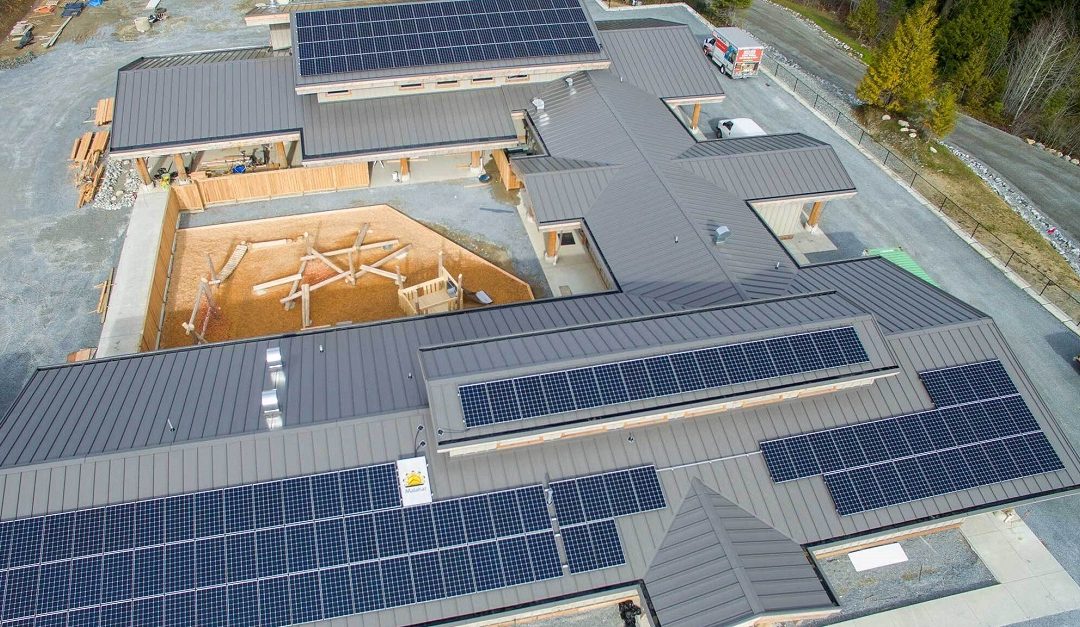By Sasha Milam, Gustavson Content Curator. Pictured: Malahat Nation’s recently completed solar project. Photo by Dan Pasmans.
MBA 596 is a chance for students to test their newly expanded knowledge of business best practices by taking on a consulting project at the culmination of their degrees. Over the years, student projects have ranged from advising non-profits on national expansion, to investigating the role of smart agriculture in global food security and everything in between.
Each term has its share of notable new project topics; one of them is chosen as the winner of the Ritchie Foundation – MBA Best Capstone Project Award. This year’s winner was a stand-out by any standards: a clean energy roadmap for Vancouver Island’s Malahat Nation.
Chief George Harry of Malahat Nation has been a strong supporter of the project for years. “The UVic-Malahat capstone project is innovative and ties in with everything that Malahat is working towards. The project is culturally inspired by the land and resources of Malahat Nation. It is moving towards stability for Malahat’s businesses and the environment as a whole.”
In response to the goals identified by Malahat Nation administrators, MBA students Tristan Gale (who is also an executive director of Malahat Nation), Omar Abdul Ghani, Steve Jones and Najib Raie undertook creating the energy roadmap as their capstone consulting project.
As their report notes: “Malahat is growing both in terms of members living on its lands, and in terms of ambition for the future it can provide for them. It has a strong economic plan, and recent land acquisitions together with improved infrastructure are needed to help deliver economic stability to its members. The business park and industrial lands are the engine for this economic growth.”
Unfortunately, Malahat Nation’s goals for enhanced economic use of their lands will outstrip the energy available to them by 2023, the MBA team found after discussions with administrators, reviewing current utility use and evaluating Malahat Nation’s economic development plans. This pointed to the need for additional power development, which would also have to align with the community’s commitment to sustainable land use and stewardship.
It was clearly a project with enormous potential – and one that was outside the scope of a one-term consulting project.
“We started by developing the parameters of what we could accomplish during our project,” says Tristan. “We wanted to offer an analysis of the steps needed for Malahat Nation to achieve its goals of energy self-sufficiency. Our mission with the project was to evaluate the community’s current and future energy use; evaluate opportunities to add clean energy to supplement what BC Hydro provides; and identify job opportunities and economic benefits for the community via this clean energy expansion.”
There were several geographic advantages within Malahat lands that offered options to achieve these goals, the students found. One of these elements is a man-made lake at high elevation, which can be harnessed for hydro power. Another is a recently completed solar energy installation on Malahat lands, which can augment the lake’s hydro infrastructure during the dryer summer months. Wind power is also an option.
“These offer some really compelling opportunities for how Malahat Nation can meet their energy needs in a way that’s in harmony with the land, which is a priority for them,” says Tristan.
The student team brought a usefully diverse array of knowledge to the project: Steve and Omar have engineering backgrounds, while Najib has extensive business administration experience. Tristan, for his part, has a degree in biology and has worked in environmental stewardship.
They drew on all of these skills during the term, as well as lessons from their recently completed coursework, and the result was a detailed, thoroughly researched and collaboratively built plan. The three steps outlined in the plan progress from the development of a sub-station (step one), to developing a micro-grid with battery storage (step two) and culminate with full hydroelectric and pump storage installation.
“Infrastructure is the key to unlocking the value of Malahat lands,” says Tristan. “There’s a long way to go until we have built these up to their full potential, but we have taken the first step now with the research and planning done. It’s an exciting project. I’m looking forward to seeing it completed, and what can be done once Malahat Nation has fully unlocked the renewable energy in their land.”


